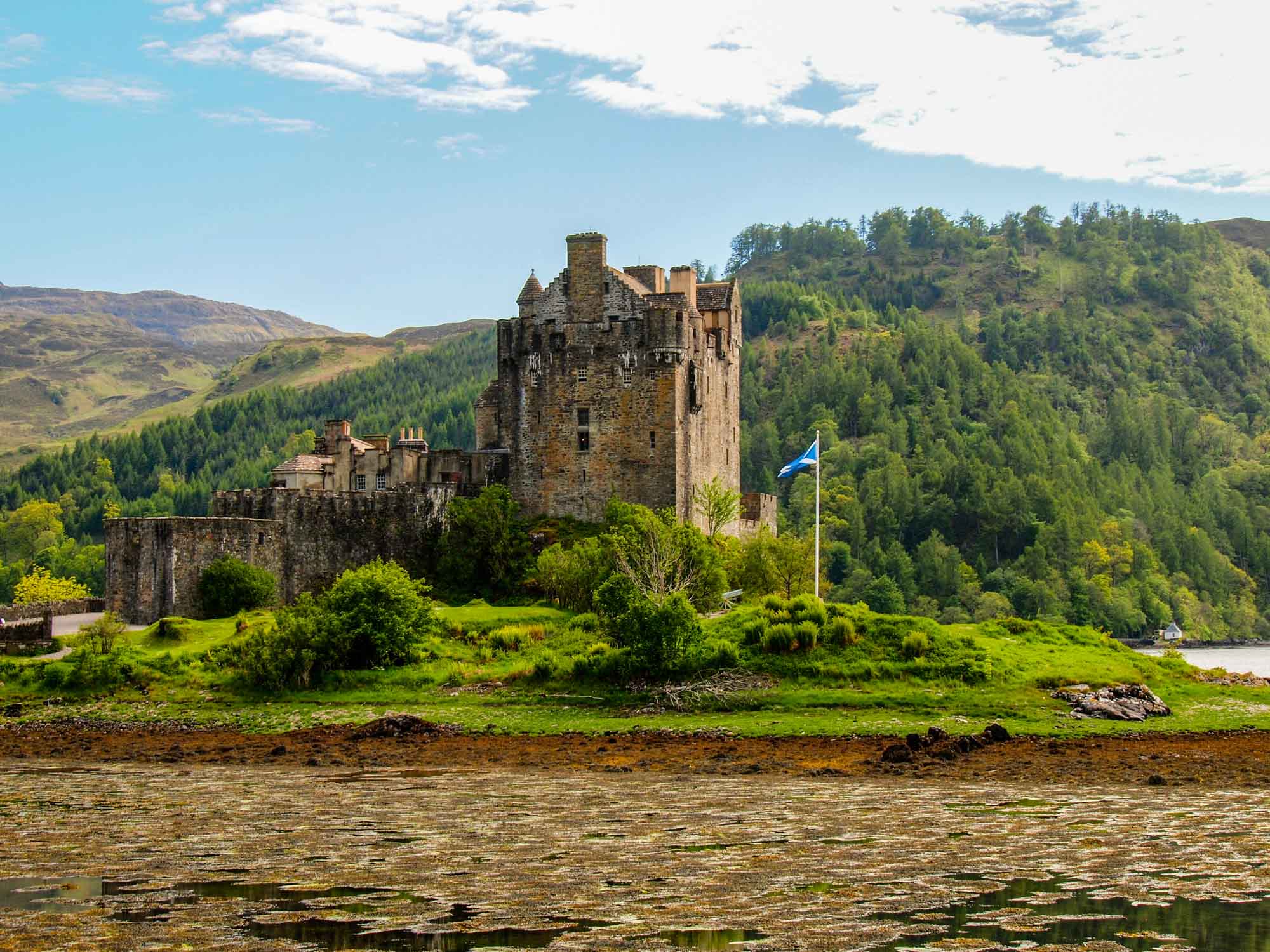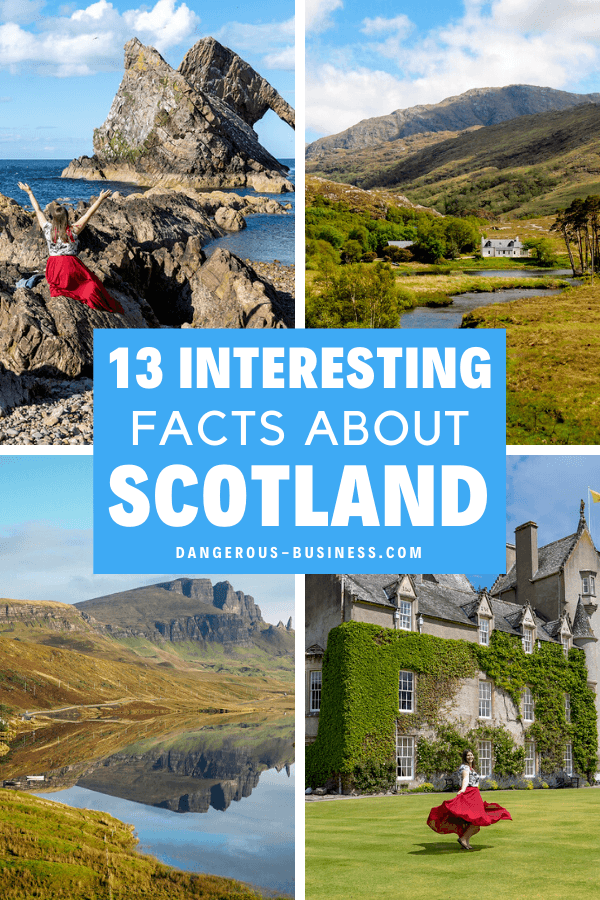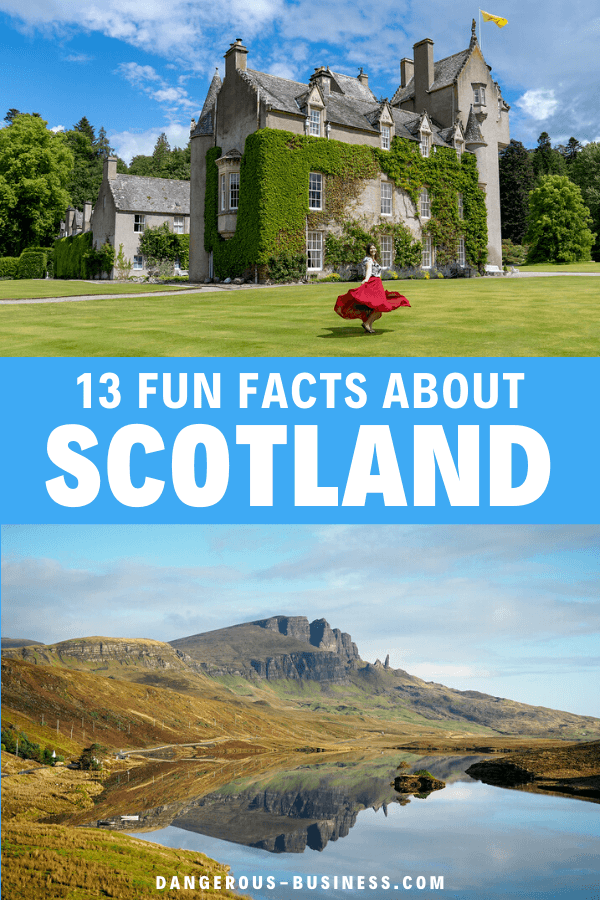Did You Know? 13 Fun Facts About Scotland

When people ask me about my favorite places in the world, Scotland is always, always near the top of my list. This surprises many people; I guess maybe Scotland isn't “exotic” enough for most people to assume it would be a favorite?
But, to me, Scotland has everything I love in a destination: It's beautiful, from its Lowland cities to its Highland lochs to its many Isles. The people are warm and friendly. It's easy to get around as a tourist. And those Scottish accents don't hurt, either.
I also love that Scotland is just dripping in history. I'm a big history nerd, so the fact that I learn something new every time I visit draws me back to Scotland again and again.

13 fun Scotland facts you should know
If you want to learn something new about one of my favorite places today, here are a bunch of fun facts you might not know about Scotland:
1. Is Scotland really a country?
So let's get this one out of the way first. Can I *really* cite Scotland as one of my favorite countries?
Technically speaking, Scotland is not an independent country. It's part of Great Britain and the United Kingdom (Great Britain is made up of England, Wales, and Scotland, while the UK's full official name is the “United Kingdom of Great Britain and Northern Ireland”).

People have lived in Scotland for millennia, but the Kingdom of Scotland didn't emerge until the Middle Ages. In the early 1600s, King James VI of Scotland also became king of England and Ireland. But it wasn't until 1707 that an official political union was formed by the creation of the Kingdom of Great Britain.
Scotland would then go through a period where it lost a lot of power to the new Parliament of Great Britain and the UK monarchy. It wasn't until 1997 that Scotland was able to form its own independent Parliament again.
Today, Scotland still uses the British Pound (though they do print their own bank notes through the Bank of Scotland), and only has limited self-governing power. Scottish people also carry UK passports, and the UN recognizes it as part of the United Kingdom.

BUT, I personally still consider Scotland to be its own entity. Scotland has its own character, its own history, its own culture, and of course has increasingly talked of independence in recent years. So, while it's not technically a “country,” many people (me included) still treat it as one.
2. The mighty unicorn
Perhaps my favorite Scotland fun fact is that the national animal is a unicorn. The unicorn has been a symbol of Scotland for centuries, and the reason behind this perfectly captures the Scottish spirit.

England has always been represented by a lion. And if you know anything about the history of Great Britain, you'll know that England and Scotland have been at odds (and sometimes literally at war) throughout history.
In old myths, guess which animal was said to be the only one that could defeat a lion? Yup, a unicorn.
Scotland's Royal Coat of Arms used to feature two unicorns. Today, the royal coat of arms of the United Kingdom still represents Scotland with a unicorn.
3. The water of life

Scotland is known around the world for its single-malt whisky, usually just known as “Scotch.” But while most people associate Scotland with whisky, it wasn't “invented” there like many people assume.
Distillation is not a “new” process. In fact, people all the way back in Mesopotamia and Ancient Greece were distilling things in order to produce perfumes. The distillation of alcohol was first recorded in Europe, where monasteries distilled it from wine to be used mostly for medicinal purposes.
This is how the process first arrived in Ireland, where true whisky distillation (making alcohol from distilled grains) was “invented” in the early 1400s before making its way over to Scotland. The word “whisky” in fact comes from the Old Irish uisce beatha, which translates to “the water of life.”

Ireland is home to the oldest licensed whisky distillery in the world (Old Bushmills Distillery, which received a license in 1608), but Scotland has perhaps become even more synonymous with the “water of life” than any other country.
In order for whisky to be “Scotch,” it has to have been distilled in Scotland from water and malted barley, and be aged for a minimum of 3 years in an oak barrel. There are lots of other technical requirements, but those are the main ones.
Today, Scotland has more than 125 whisky distilleries in six different whisky regions. Some of the most famous are Speyside (home to the official Malt Whisky Trail) and Islay (home to the incredibly peaty whiskies).

READ MORE: Your Complete Guide to the Malt Whisky Trail in Scotland
4. A country of islands
Scotland inhabits part of the island of Great Britain, but did you know that it itself has more than 900 offshore islands of its own??
Not all of these islands are inhabited or even visit-able, but many of them are. Island-hopping in Scotland is therefore very popular (and highly recommended!).
Scotland's islands are divided up into the Inner Hebrides, Outer Hebrides, Orkney Islands, and Shetland Islands.

In the Outer Hebrides, you have islands like the Isle of Lewis and Harris, Barra, and the Isle of St. Kilda. In the Inner Hebrides, you'll find Islay and its whisky, Colonsay, the Isle of Iona, Staffa (famous for puffins and Fingal's Cave), the Isle of Mull, and the famous Isle of Skye. And both the Orkneys and Shetlands are home to the ruins of ancient settlements with Viking ties.
5. Shortest commercial flight in the world
Because of all these little islands dotted all over, Scotland is home to the world's shortest commercial passenger flight. The flight runs between two of the Orkney islands (Westray and Papa Westray), which only lie 1.7 miles apart. The flight, operated by Loganair, is officially only 2 minutes long!
Loganair runs this flight mostly for local islanders, but it's flown multiple times per week in small 8-seater planes. Tickets can be bought for as low as £14.50 return.

Another Scottish isle flight to put on your bucket list is the flight that flies to the island of Barra. This flight is unique because the airport “runway” on Barra is just a stretch of sandy beach!
6. Why so many redheads?
Scotland has one of the highest proportions of red-haired people in the world. Worldwide, less than 2% of people have red hair. In Scotland, though, that percentage is somewhere between 6% and 13% (depending on the source).

Red hair is far more common across northern European countries than it is anywhere else in the world. Some assume that this is because of northern Europe's Viking history; the Vikings made their way to most of the nations that today have larger redhead populations.
But the real reason is actually much more fascinating and based in science: people with red hair are able to produce Vitamin D more efficiently, helping them thrive in places with less sunlight. How freaking cool is that??
7. Home to Harry Potter

Speaking of redheads, the most famous red-headed family in literature has ties to Scotland. The Weasleys – along with all the other Harry Potter characters – were the brainchild of Scottish author JK Rowling.
Rowling was born in England, but has called Edinburgh, Scotland, home since 1993. She wrote most of the Harry Potter books while living in Scotland, and the fictional Hogwarts School of Witchcraft and Wizardry is found in the Scottish Highlands.
Because of these ties, there are lots of Harry Potter things to do in Edinburgh, as well as throughout Scotland (you can even ride the Hogwarts Express!).

READ MORE: A Harry Potter Lover’s Guide to Edinburgh, Scotland
8. Of myths and monsters
Harry Potter is a modern fantasy with Scottish ties, but to think that Scotland could be home to wizards and magical creatures isn't really that far of a stretch (unicorns, remember?).
Scotland's mythology includes everything from giants living in sea caves (Fingal's Cave on Staffa), to shape-shifting selkies that can transform from seals to beautiful maidens, to faeries that inhabit rock pools and stone circles.

But probably the most famous Scottish legend is that of Nessie, the Loch Ness Monster. This dinosaur-like monster is said to inhabit Loch Ness, one of Scotland's largest lochs (lakes) in the Highlands.
While the Nessie myth really took off in the 1930s, there are accounts of a Loch Ness Monster in Inverness way back in the 5th century! All “sightings” of the monster in modern times have been proven to be fake, but Nessie-seekers still flock to the lake in hopes that the mystery will finally be solved.

9. Home of golf
Scotland is the home of golf. The modern game of golf was developed in Scotland, and the The Royal and Ancient Golf Club of St Andrews is the world governing body of the game. The game has been played in Scotland since the Middle Ages, and the Old Course at St. Andrews itself dates back to at least the mid-1500s.
Scotland, unsurprisingly, has lots of golf courses (nearly 600 of them, in fact), and golf tourism is very popular.

10. Scotland's TV ties
Scotland engineer John Logie Baird is credited with contributing a lot to the modern TV. While Baird didn't “invent” the TV (a common misconception!), he did make massive contributions to the technology. He successfully transmitted the first television picture in 1925, and his Baird Television Development Company is credited with the first transatlantic television transmission in 1928.
Thanks to his innovations in television systems, Baird was named one of the 10 greatest Scottish scientists in history.
11. Scotland on the screen

Speaking of Scotland and the screen… let's talk about a couple well-known Scottish movies and TV shows!
We can't talk about Scotland movies without mentioning “Braveheart.” The 1995 Mel Gibson film was a hit, both with audiences and critics (it even won 5 Academy Awards), but Scotland natives largely roll their eyes at it. Historically speaking, the movie got a lot wrong.
While the title character of William Wallace was indeed involved in the First War of Scottish Independence, the movie paints him as a commoner when he was actually nobility. He also never had any relationship with Isabella (she was a child at the time). He wouldn't have painted his face blue, either (that was a habit of ancient Celts and Picts), nor would he have worn a kilt, considering they hadn't even been invented yet.
But perhaps my favorite “that's not right” fact about “Braveheart”? It was largely filmed in Ireland!

If you're looking for a period piece about Scotland that gets it mostly *right,* look to Outlander instead. The hit STARZ TV series gets a lot right about Scotland in the 1700s, including a lot of the details surrounding the Battle of Culloden.
READ MORE: The Best Outlander Locations to Visit in Scotland
12. A land of 3 languages
This is something new I learned while researching this post: Scotland has three official languages. Those languages are English, Scottish Gaelic, and Scots.
Scottish Gaelic is an ancient Celtic language that evolved from Old Irish. It was (and is) mostly spoken in the Highlands and the Hebrides. Scottish English is the regular English you or I know, spoken with a Scottish accent. Scots, though, is an interesting language that some people argue is a dialect and not a separate language at all.
Scots is a Germanic language that's closely related to English. It evolved from Old/Middle English in Northumbria, so it's still related to English. But it was also influenced by Latin, Norse, and even Norman French. So while English-speakers can often understand Scots, it's still considered a separate language with its own history. (If you want to learn more about it, I recommend this video.)

13. What is a haggis?
While some mischievous Scots will try to convince you that a haggis is an animal that roams around the Highlands, the truth is that it's a man-made food. The main trappings of a haggis include the offal (internal organs) of a sheep mixed with suet, oatmeal, onions, and spices. Traditionally, this would all be cooked inside a sheep's stomach.
Dishes similar to this have been around since ancient times; it was an easy way to deal with all those innards directly after a hunt. And while there's some question about where the dish “officially” originated, it's considered to be Scottish.
In fact, haggis is the national dish of Scotland today, and even has a whole poem dedicated to it.

Another interesting fact about haggis? It's been illegal to import haggis into the US from the UK since 1971, when the US enacted a ban on food containing sheep lung. So if you're an American of Scottish decent, you've got to get your haggis elsewhere.
Want more Scotland?
I have a lot of Scotland content on my site! Here are more Scotland posts you might be interested in:
- The Perfect Itinerary for 3 Days in Edinburgh, Scotland
- Discovering Inverness: 3 Days in Scotland’s Highland Capital
- 8 Harry Potter Things to Do in Edinburgh
- The Best Outlander Locations to Visit in Scotland
- A Non-Drinker Travels the Scotch Whisky Trail – And You Can, Too!
- The Perfect 10-Day Scotland Road Trip Itinerary for the Whisky Lover
Like the Scotland photos you see here? They're all available to purchase as prints over on Smugmug!
Which of these Scotland facts surprised you the most?
Pin it for later:



Amanda Williams is the award-winning blogger behind A Dangerous Business Travel Blog. She has traveled to more than 60 countries on 6 continents from her home base in Ohio, specializing in experiential and thoughtful travel through the US, Europe, and rest of the world. Amanda only shares tips based on her personal experiences and places she's actually traveled!










Hey, nice posts, but I’m really irked by point 1!
Scotland is absolutely a country in it’s own right, a point I do not think you clarified in your post. Yes it’s part of the United Kingdom, but all four nations are unmistakably their own countries.
It’s not a “country” by UN definitions (as in, it’s not recognized as an independent nation by any other nation), but I personally do consider it its own country! (Which I do say in the post. 🙂 )
Thanks for the shout-out for where my dad came from ( and a fantastic wee island to visit) – the Isle of Colonsay!! I should also add that you forgot the FOURTH language that many Scots, including myself, speak: there is English, Gaelic, Scots, and BAD!! Just a gentle warning for those visitors with delicate ears…!! 🙂
Haha! I do love you Scots, bad language and all!
One of my favorite places on Earth! I’ve been 3 times – one was visiting my daughter who was lucky enough to spend a semester abroad there studying at the University of Edinburgh – and there is still so much to see. My next trip there I hope to visit some of the Islands and more of the Highlands. (By the way, have you watched Shetland? You might enjoy it)
The Highlands and islands are amazing – I’ve visited several, but always want to go back!
I love this post Amanda! I clicked on it as I am planning a trip to Scotland once this pandemic is over. I certainly didn’t know Scotland is known for its single-malt whiskey or that there are more than 900 offshore islands in Scotland. Checking out some of those islands will be on my itinerary! Excited to read your next post! X
Glad that I could introduce you to some new Scotland facts, Hannah! Scotland is such a cool place, and I hope we’ll all be able to get back to visiting it soon.
5. The oldest known tree in Europe is the Fortingall Yew in Perthshire, Scotland. It is between 2,000 and 3,000 years old.
Yes! That’s another very fun fact. I’d love to visit that tree someday!
Last year, I got to hear about the real story of “Braveheart” from our tour guide/driver during a day excursion from Edinburgh. Seeing where a few of the main events occurred enhanced the experience too.
The natural landscape is just stunning!
Scotland has some really interesting history! And yes, the landscapes are some of the best.
Love this post! I actually had no idea that “whisky” originally translates as “water of life” (also Ireland spells it “whiskey” while in Scotland it’s “whisky” and I never really understood why). All your photos are gorgeous by the way! I was on Skye a few months ago and wanted to get that photo of Storr reflecting in the water, but it did NOT come out the way I wanted haha. Scotland sure is lovely in the sun.
I think the whisky-whiskey spelling difference goes back to the different translations of it from the different forms of Gaelic. Not sure how the US decided on which spelling version it would use (we spell it “whiskey”), though!
As for that shot on Skye, we got SO lucky that day. It was dead calm that morning, hence that amazing reflection!